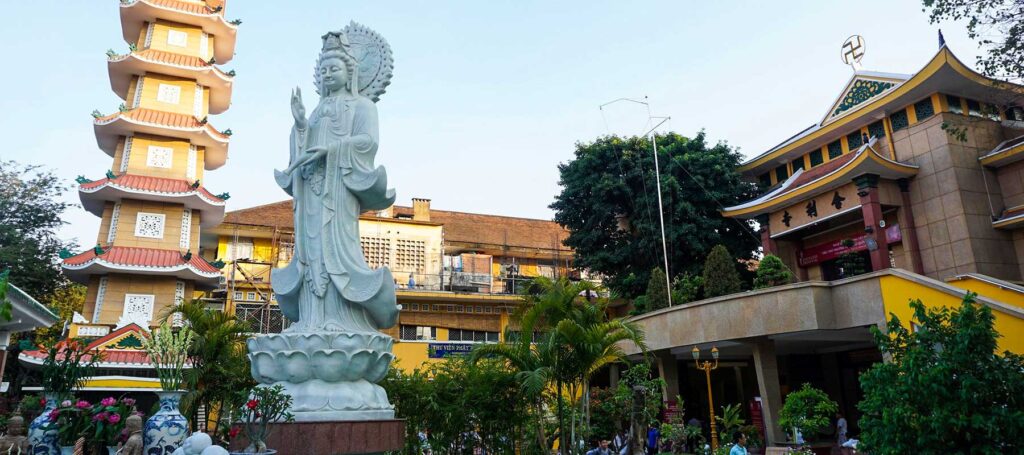Xa Loi Pagoda, built in 1956, holds historical significance as a Buddhist site in Ho Chi Minh City. Beyond its architectural charm, the pagoda played a important role in Buddhist demonstrations against the Ngo Dinh Diem regime in 1963, foreshadowing increased US involvement in Vietnam. Today, the pagoda stands as a peaceful sanctuary, featuring a prominent seated Buddha statue and a towering seven-tiered tower, embodying the resilience and unity of Buddhism in Vietnam.
Address & Opening times
- Address: Xa Loi Pagoda is located at 89 Ba Huyen Thanh Quan Street, Ward 7, District 3, Ho Chi Minh City, Vietnam.
- Opening times: The pagoda is open daily from morning to evening, typically from 6:00 AM to 5:00 PM.
- Entrance fee: There is no specific entrance fee for visiting Xa Loi Pagoda. However, it is appreciated to make a donation to support the maintenance and upkeep of the pagoda
How to get there
Xa Loi Pagoda is located in District 3 on the edge of District 1. Ben Thanh Market is around 1.7 km away and the War Remnants Museum is about 1 km away. Walking may be too far, so the most convenient option is to take a taxi. The taxi fare will depend on your starting location within the city center but generally ranges from 50,000 VND to 80,000 VND. Alternatively, you can use ride-hailing services like Grab, where you can input the pagoda’s address to see the price upfront and avoid any confusion where to go to.
Visiting tips & rules
- Dress code: Dress modestly and respectfully, covering your shoulders and knees. Avoid wearing revealing or inappropriate clothing.
- Best time to visit: The pagoda can be visited throughout the year, but it is recommended to go during the early morning or late afternoon when it is less crowded and the weather is more pleasant.
- Photography: Photography is generally allowed, but be mindful of your surroundings and the activities taking place. Avoid using flash or making excessive noise that could disturb others. Always ask for permission before taking photos of individuals who are praying.
- Special occasions: Xa Loi Pagoda celebrates various Buddhist holidays such as Buddha’s birthday, Ghost Festival, Lantern Festival, and Vietnamese New Year. On these occasions, the pagoda tends to be crowded with worshippers and visitors. Additionally, the pagoda hosts weddings, particularly Buddhist weddings, which attract many couples. Check the calendar for these special events if you’re interested in experiencing the festive atmosphere.
- Visit other nearby sights: While there are no sights in direct walking distance, you can explore other attractions in District 3 such as Vinh Nghiem Pagoda, Tan Dinh Market, the Tan Dinh Church (Pink Church), and the War Remnants Museum. These nearby attractions provide an opportunity to further immerse yourself in the cultural richness of the area.
History of Xa Loi Pagoda
Xa Loi Pagoda holds a significant place in the history of Buddhism in Vietnam. The construction of the pagoda began in 1956 and was completed in 1958, making it one of the relatively newer pagodas in Ho Chi Minh City.
The pagoda gained immense importance during the 1960s when it became a focal point for Buddhist activism and opposition against the government of President Ngo Dinh Diem. Buddhist monks and followers used Xa Loi Pagoda as a platform to voice their grievances and advocate for religious freedom and equality.
On June 11, 1963, Thich Quang Duc, a Buddhist monk, set himself on fire in protest against the religious discrimination and persecution imposed by the government of President Ngo Dinh Diem. This act of self-sacrifice, carried out in the busy intersection near Xa Loi Pagoda, shocked the world and brought international attention to the plight of Buddhists in Vietnam.
The most notable event in the pagoda’s history occurred on August 21, 1963, when government forces, under the orders of President Diem, launched a violent attack on the pagoda. This assault, known as the Xa Loi Pagoda raids, resulted in the destruction of parts of the pagoda, the arrest of 250 monks and the loss of numerous lives.
However, in the years following the events of 1963, the pagoda was reconstructed and restored. Today, it stands as a symbol of resilience and peace, attracting people from all over the world who come to pay their respects and explore its serene surroundings.
Architecture & highlights of Xa Loi Pagoda
The architectural style of Xa Loi Pagoda is predominantly influenced by Vietnamese Buddhist traditions. While incorporating modern elements, the pagoda retains the essence of traditional Vietnamese pagoda architecture, characterized by its intricate roof lines, decorative motifs, and ornate details.

The main buildings within the pagoda complex include:
Main Hall

The central building, also known as the Buddha Shrine Hall, is the heart of the pagoda.

It houses a large seated Buddha statue, intricately carved and adorned with gold. The hall is the place where locals come to pay their respects and meditate.
Bell Tower

Adjacent to the main hall, the pagoda features a tall bell tower. This tower serves as a symbol of Buddhist traditions and serves the purpose of calling monks and devotees to prayer and meditation.
Stupas and Monuments
Throughout the pagoda grounds, you will find numerous stupas and monuments dedicated to revered Buddhist figures and monks. These structures often feature intricate details and serve as places of reverence and remembrance.
Meditation Hall
Xa Loi Pagoda also includes a meditation hall where practitioners can engage in quiet contemplation and mindfulness practices. The hall provides a tranquil environment for those seeking inner peace and spiritual growth.



